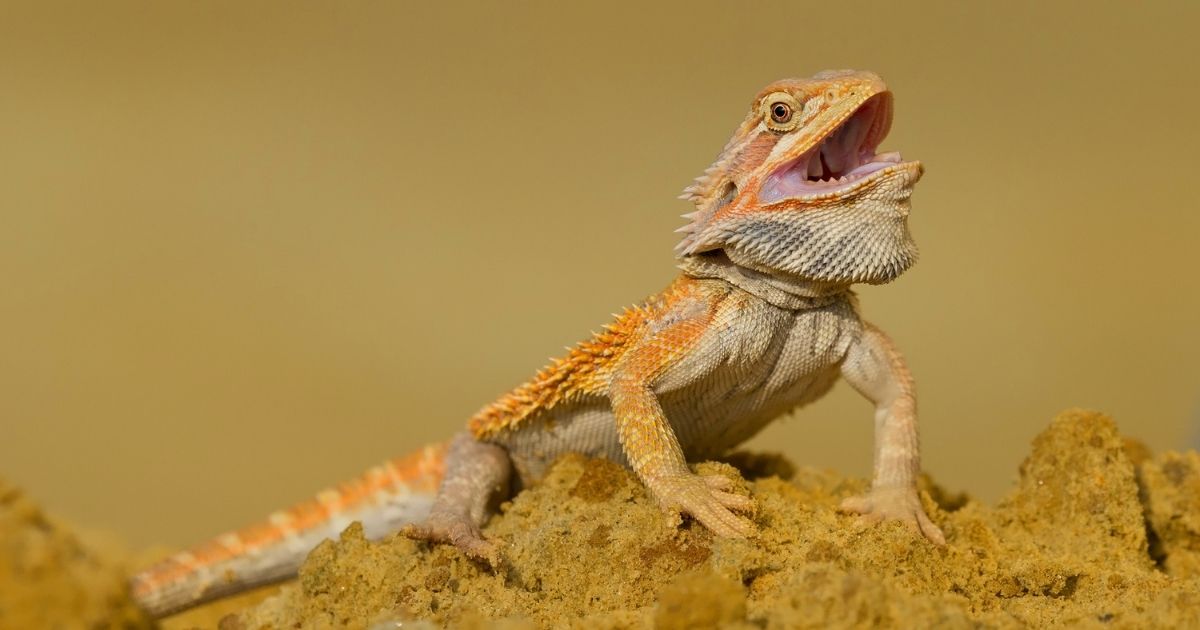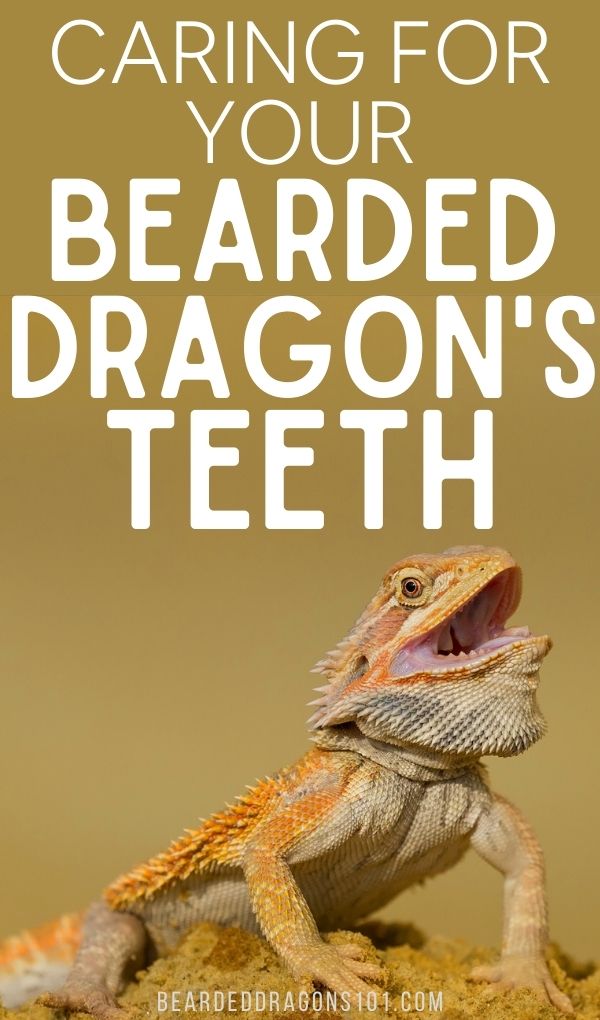
The UC Davis School of Veterinary Medicine recently released a case study about Rex, a 5-year-old bearded dragon. This case study details how a bearded dragon’s teeth can be effected by poor oral health care and husbandry. Poor Rex wasn’t wanting to eat or drink, as he was suffering from oral inflammation, buildup, and even some exposed bone. You can read Rex’s case study (and see pictures of this teeth) here.
Understanding bearded dragon teeth and basic oral health is a critical part of bearded dragon ownership. Your bearded dragon’s teeth need to be cleaned and inspected routinely. If neglected, they can lose their teeth, wear their teeth down, or suffer from painful gum disease.
Let’s dig deeper and discuss what you need to know about their teeth and how to care for their oral health, so you can avoid a stressful situation like Rex and his owners experienced.
Do Bearded Dragons Have Teeth?
First things first. Yes, bearded dragons have teeth. Unlike humans, they’re born with their teeth, so they can eat protein and vegetation from day one. Their teeth are small and barely visible, especially when they’re babies.
Their teeth are carried near the surface of their gums and fused to their jawbone, rather than in tooth sockets. Over time, they wear down and eventually can wear down so much that they become part of the surface of their jawbone.
It was once thought that none of a bearded dragon’s teeth would ever be able t0 re-grow if lost, but new research has found that the bearded dragon is one of the rare vertebrate species with both polyphyodont and monophyodont teeth. Polyphyodont teeth can be slowly replaced over time. Monophydont teeth cannot be replaced; once they are lost, they don’t regrow.
Researchers from the University of Helsinki in Finland (Salomies, 2019) found that a previously uncharacterized set of genes within the tissue of a bearded dragon’s developing tooth could determine whether or not that tooth will be replaced.
So, while it was once thought that bearded dragons could not re-grow their teeth at all, we are now learning that some of their teeth (the polyphyodont teeth) are able to slowly re-grow over time.
How Many Teeth Does a Bearded Dragon Have?
The number of teeth a bearded dragon has varies, typically ranging from 11-17 on each side of their upper jaw and 13-20 on each side of their lower jaw.
How to Open Your Bearded Dragon’s Mouth
Using your thumb and forefinger, carefully apply gentle pressure to the sides of your bearded dragon’s head, just above his mouth, near his eyes. The pressure should force your beardie to open its mouth so you can inspect or clean its teeth.
Here’s a veterinarian showing you how to open a bearded dragon’s mouth:
How to Clean Your Bearded Dragon’s Teeth
Your bearded dragon’s teeth need routine care. Cleaning their teeth can help prevent periodontal disease and add to their overall quality of life. Recent research by Lafeber shows that, without proper oral care, bearded dragons are particularly susceptible to periodontal disease.
To clean your bearded dragon’s teeth, moisten a small cotton ball with water and gently wipe around its teeth and gums. Do this once or twice a week. Do not attempt to use toothpaste!
Some veterinarians may recommend moistening the cotton ball in a diluted chlorhexidine solution rather than water. This is dependent on a variety of factors, so please follow the advice of your veterinarian. Chlorhexidine is an antiseptic and disinfectant effective against yeast, viruses, fungus and bacteria. Never give full strength chlorhexidine to your beardie, and be sure to seek your veterinarian’s guidance before attempting to use it.
Inspecting Your Bearded Dragon’s Teeth
The UC Davis Exotic Animal Medicine School encourages all exotic pet owners to discuss oral health and cleaning with their veterinarians during their annual checkups in order to prevent or manage oral disease. (source)
In addition to inspecting their teeth at the annual checkup, you can also do your own simple inspection when you clean their teeth. Look for inflammation, discoloration, and missing or broken teeth. Report anything unusual to your veterinarian right away.

Signs Your Bearded Dragon May Have Periodontal Disease
Lizards, especially bearded dragons in captivity, are predisposed to periodontal disease which can progress into severe calculus buildup, gingivitis (inflammation of the gums), gum recession, mouth rot, and bone infections. Researchers suspect this to be related to their diet, particularly in bearded dragons.
Here are 10 signs your beardie may have periodontal disease:
- Loss of appetite
- Lethargy
- Dehydration
- Inflammation of the mouth
- Receding gum line
- Plaque build-up
- Bone exposure
- Discolored teeth
- Missing/lost teeth
- Brown or black teeth
If you suspect your bearded dragon may be suffering from an oral heath concern, please seek medical care from your veterinarian.

Possible Treatment Options For Bearded Dragon Periodontal Disease
Depending on the severity or progression of the disease, the treatment options your vet suggests may include:
- Professional dental cleaning
- Diagnostic work up (blood work, radiographs, and/or an echocardiogram) to assess other contributing factors
- Antibiotics
- Anti-inflammatories
- Adjustments to their at-home care, diet, lighting, and/or housing enclosure
- Ultrasonic dental scaling under anesthesia
Long-term management of this disease may involve oral exams every few months, brushing the teeth with a specialized formula and technique, and/or follow-up care with dental radiographs and cleanings.
5 Things That Can Damage Your Bearded Dragon’s Teeth
Diet and environment play critical roles in your beardie’s oral health. These five things can contribute to tooth damage, loss, or disease:
- Too many soft foods, such as only feeding soft-bodied insects
- Sugary foods, such as offering too much fruit
- Vitamin or mineral deficiencies, such as a calcium deficiency causing MBD (metabolic bone disease)
- Physical impact from glass-surfing or fighting with another bearded dragon
- Attempting to feed large, hard vertebrates that struggle with your bearded dragon
What To Do If Your Bearded Dragon Has Black Teeth or Gums
Black teeth or gums are cause for concern and warrant a visit to your veterinarian. It may be disease or infection caused by a poor diet, such as soft foods, sugary foods, or deficiencies. Deficiencies are common in captive bearded dragons (source).

Preventing Teeth Issues and Oral Diseases
Diet
Feed your bearded dragon a mix of crunchy and soft foods, rather than soft foods only. Crunchy protein (like Dubia Roaches) and crunchy vegetables (cut small) are good choices. Limit sugary foods. Supplement with calcium powder (like this one) and be sure you’re using proper lighting in the enclosure so they can properly metabolize the nutrients in their food.
Stress
Limit stress, such as fighting with another bearded dragon or seeing their reflection in glass. Fighting, thrashing, and other such behaviors can result in tooth damage or tooth loss.
Cleaning
Clean and inspect their teeth on a regular basis, including during their annual exam with a veterinarian.
Summary
Understanding your bearded dragon’s teeth and how to perform basic oral care is a critical part of bearded dragon ownership. Your bearded dragon’s teeth need to be cleaned and inspected routinely. If neglected, they can suffer from tooth loss, mouth pain, and/or gum disease.
You might also like: Are Bearded Dragons Good Pets?

